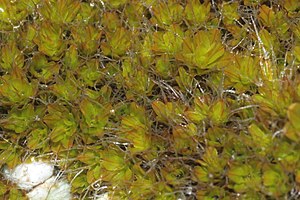Syntrichia montana
| Syntrichia montana | ||||||||||||
|---|---|---|---|---|---|---|---|---|---|---|---|---|

Syntrichia montana |
||||||||||||
| Systematics | ||||||||||||
|
||||||||||||
| Scientific name | ||||||||||||
| Syntrichia montana | ||||||||||||
| Nees |
Syntrichia montana (German Mountain composite tooth moss ) is a moss -Art in the family pottiaceae .
description
The plants, up to 4 centimeters in size, form dense, cushion-shaped lawns that shimmer grayishly through the glass hair. The dry, moist, upright leaves are spatulate, usually slightly narrowed in the middle and rounded at the tip. The leaf margins are rolled over from below to just above the middle of the leaf. The strong brown leaf vein ends at the tip of the leaf in a long, toothed, mostly hyaline glass hair. The upper (ventral) side of the rib shows papillary cells, the cross-section of the rib shows 5 to 6 rows of narrow-lumen, brown-red stereids.
The lamina cells are rectangular and hyaline on the base of the leaf next to the rib, shorter and narrower towards the edge. In the upper half of the leaf, they are small, rarely larger than 10 micrometers and densely covered with papillae, which often protrude above the cell walls and make them only indistinctly visible under the microscope.
The gender distribution is diocesan . The red seta is up to 15 millimeters long, the upright to slightly curved and cylindrical capsule up to 3 millimeters long. The pointed lid is about two thirds of the length of the capsule. Peristome teeth are twisted, their basement membrane is 0.3 millimeters high. The spore size is 10 to 16 micrometers.
Location claims and distribution
The species grows on sunny, dry limestone, more rarely sandstone, Nagelfuh or base-rich silicate rock, also on walls, piles of reading stones and the like, mostly directly on the rock, less often over a thin layer of soil or humus.
In Germany, the main distribution area is in southern and central Germany. Worldwide occurrences are given for Europe, western Asia and North America.
variety
Populations of plants whose leaves have only a short spiked tip are described as Syntrichia montana var. Calva (Durieu & Sagot) JJ Amann. In Germany, this variety is much rarer than the main form and hardly differs from it in terms of ecology and sociology. It should rather prefer more basic substrates.
Taxonomy
The species was first described in 1819 by Christian Gottfried Daniel Nees von Esenbeck . In 1826, Samuel Élisée von Bridel described a kind of Syntrichia intermedia , which is usually considered a synonym of Syntrichia montana ; however, some taxonomists still consider this name to be the valid name of the species (cf. e.g. Düll 2006). For a long time it was preferred in the specialist literature in the recombination Tortula intermedia (Brid.) De Not. mentioned. Other taxonomists placed the species in the genus Barbula . There are therefore numerous other synonyms.
The temporarily classified as a subspecies Syntrichia montana Nees subsp. handelii (Schiffner) Podp. is now again considered a separate species Syntrichia handelii (Schiffner) Agnew & Vondracek. The North American Syntrichia rupicola Allen was mistakenly synonymous with this species for a time by William Campbell Steere.
swell
- Jan-Peter Frahm , Wolfgang Frey : Moosflora (= UTB . 1250). 4th, revised and expanded edition. Ulmer, Stuttgart 2004, ISBN 3-8252-1250-5 , p. 307.
- Martin Nebel, Georg Philippi (ed.): The mosses of Baden-Württemberg. Volume 1: General part, special part (Bryophytina I, Andreaeales to Funariales). Ulmer, Stuttgart 2000, ISBN 3-8001-3527-2 , p. 242.
Individual evidence
- ^ A b Ken Kellman: A Synopsis of Recent Literature on the Genus Syntrichia in the Northern Hemisphere. on-line. download
- ↑ Ruprecht Düll (2006): Provisional catalog of the liverwort and leaf moss in South Tyrol (Province of Bozen). Gredleriana 6/2006: 69-114. PDF